
* This post is kindly sponsored by the companies listed at the end of this post, but all opinions are my own. *
It can be quite scary to trust an airline with your medical equipment during a flight, especially if you’ve seen some of the horror stories in the news! I used to get very anxious about travelling with my wheelchair, particularly after encountering several bad experiences; but it is important to remember that for every negative experience, there are hundreds of wheelchair users flying every day who don’t have any issues. But in order to try and minimise the chances of your wheelchair getting lost or damaged, I wanted to share some of the tips and tricks I have learnt over the years!
Firstly, it is vital that you inform the airline if you are planning to travel with your own equipment, particularly if you need to keep your wheelchair with you until you board the aircraft. Although I would suggest doing this as soon as you book your flight tickets so the airline has plenty of time to arrange everything, including any passenger assistance you may require. You will also be asked to provide specific details about your wheelchair, including the type of frame, model, dimensions and battery type/size (if applicable). Alternatively, you can use one of the airport's wheelchairs/buggies before and after your flight if you aren’t travelling with your own equipment, however, they aren’t the comfiest to sit in!
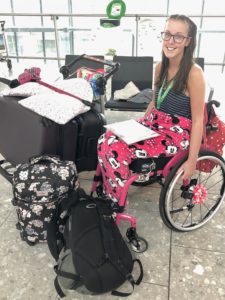
You will find several suggestions listed later on in this post that you can implement/purchase ahead of your journey to protect your wheelchair, but I would also recommend giving your wheelchair a mini service the day before your flight to ensure nothing can come loose inflight. This also provides you with a good opportunity to take note of the condition of your wheelchair, making it easier to distinguish if any damage you discover on arrival was not your responsibility. For example, I once arrived in London to find my assistance dogs lead holder completely twisted, along with a chunk missing from one of the legs on my manual frame, yet the airline tried to tell me that I couldn’t guarantee the damage wasn’t already there. For this reason, I always take a photo of my wheelchair in the airport should I need to provide any photographic evidence! I also pack any loose items such as my Bundle Bean organiser and MERU phone stand, which I can manage without during my day of travelling.
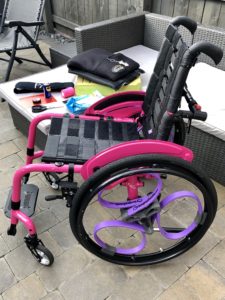
Upon arrival at the airport, it is vital that you get your wheelchair tagged at the check in desk so the baggage handlers know which aircraft it needs to go on. If your wheelchair dismantles into 2 (or more) pieces you will need to ensure they label each part, even if it hasn’t been dismantled yet. You could also add your own label and include your flight number, destination, hotel name and phone number, to ensure you can be contacted if your wheelchair goes missing. Some people even attach a photo to their own luggage tag to help remind the baggage handlers that it is vital for the owner, along with some instructions to ensure they move/lock your wheelchair without damaging it!
You may also be given the option to transfer into an airport wheelchair at the check in desk, so your chair can be boarded ahead of time with the rest of the luggage. Particularly if you are travelling with more than one piece of equipment; although I have only ever been asked this in Paris due to the fact they have very different laws! Obviously everyone’s circumstances and preferences are different, but I personally do not recommend doing this as your wheelchair could get thrown around amongst thousands of suitcases and no doubt end up getting damaged. So don’t be afraid to explain why it is imperative that your wheelchair is kept with you until you board/disembark the aircraft, should you encounter a similar situation. My experience in Paris airport was certainly not easy due to the language barriers; but once I explained my reasoning to someone who could translate, the not so understanding member of staff was miraculously able to tag my wheelchair and order it to be collected from the gate!
Once at the gate you will typically be given the option to board first, allowing you plenty of time to safely get to your seat. Although if your wheelchair dismantles in two pieces, you or your carer will be required to take it apart/fold it down at the aircraft door prior to boarding. At this point I also recommend:
removing any loose parts, such as your seat cushion or drinks holder and popping them into your hand baggage, to ensure they don’t get lost in the hold.
strapping or taping loose parts that cannot be removed with some velcro or electrical tape to prevent it getting damaged or mishandled. This is something I always do to secure my folding footplate in place!
informing the baggage handlers how to manoeuvre your wheelchair without breaking it, although this is often only necessary for people travelling with a powered wheelchair.
covering certain parts with impact guards from PYC - Wheelchair Upholstery. The strong velcro secures the custom made guards stays in place, whilst the protective yet flexible material ensures your frame is shielded from any bumps and scrapes during transit! You may even be able to attach the protective guards to your chair prior to your journey, allowing you to save time once you get to the aircraft door; although Felix managed to wrap mine around the legs of my frame in a matter of seconds, making them very easy to put on/take off!
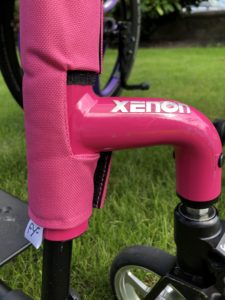
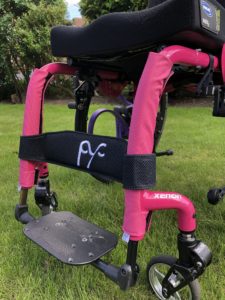
I know several manual wheelchair users have asked me whether it’s best to leave your wheelchair as one piece, or dismantle/fold it up during a flight; but I think the answer to this question depends on the type of wheelchair you have. My chair is very fragile when folded, as it has parts that stick out and therefore could easily break off; so I now choose to leave it whole, which in turn has resulted in a lot less damage. I also think it is easier yet heavier for the baggage handlers to transport, meaning they are less likely to throw it onboard. (Yes, I have literally watched several wheelchairs being thrown onto an aircraft, along with a powered chair being used as a trolly that had 2 other manual frames stacked on top!) Plus I don’t have to spend time reassembling my frame once I arrive at my destination. However, some pushchair style wheelchairs, transit chairs or manual frames are better off being folding. So it really depends on what equipment you use and how you feel. For anyone travelling with a folding device, I would highly recommend using an inflight storage bag from Bundle Bean. Unlike some of the other bags on the market that I have tried, this bag has a thick padding on the inside to protect your chair, along with a PU lining to ensure your chair is kept dry and clean during transit. It also has large external pockets, allowing you to safely store loose items such as footrests, seat pads and armrests; along with a double metal zip on the bag that can be padlocked for additional security. Alternatively, you could ask to store your folding wheelchair in the onboard wardrobe if it is small enough! Meaning you don’t have to worry about it being returned to the aircraft door on landing, or it getting damaged in the hold!
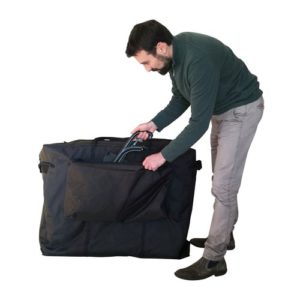
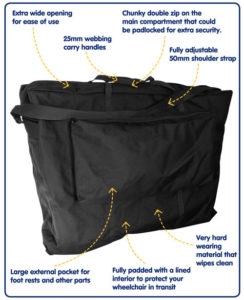
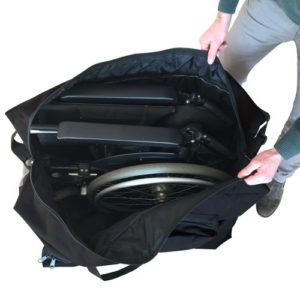
Finally, it is vital to check that your travel insurance includes cover for your wheelchair, although you should be able to take out an additional policy if it doesn’t! Whilst airlines are liable for any damage to your equipment that occurs during a flight, they will not take responsibility if it was damaged by the baggage handlers/airport staff during transit! In addition to this the amount of compensation you can claim may be limited; plus if your equipment is damaged and the airport is responsible for providing a temporary alternative while yours is repaired or replaced, it does not have to be on a like for like basis. So make sure to check whether your insurance policy covers full replacement, repairs and an interim solution should you need to hire a temporary chair while you are away!
I hope this post has given you some pointers on how you can protect your wheelchair during a flight - something I wish I knew a long time ago as it would have prevented me from writing several complaints and spending money on repairs! But please feel free to get in touch if you are still unsure or have and further questions, as I would be more than happy to help!

Thank you to the following companies for sponsoring this collection of blog posts! I will be sharing more information on each of the sponsors at the end of the series, but in the meantime you can click on the links below to learn more about their products and services:
Hi, I'm Lauren and I have been living with a collection of disabilities for the past 8 years. I initially had a passion for teaching children with special needs, but my health prevented me from pursuring my dream career. Despite this, I now love nothing more than sharing my experiences to help other people living with disabilities.
Hi, I’m Lori and was diagnosed with Ehlers Danlos Syndrome and a family of co-morbid conditions which has made life highly complex. However I constantly aim to make life as ‘normal’ and fulfilling as possible - and through this, I discovered the benefits of writing about my journey.
 GET IN TOUCH
GET IN TOUCH


